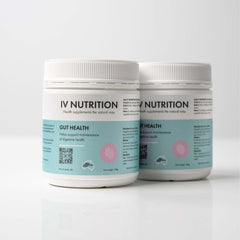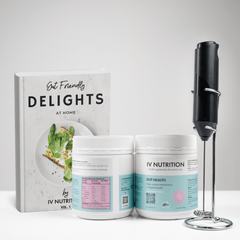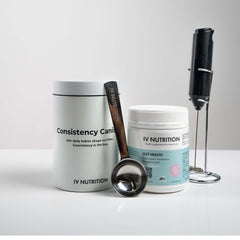In recent years, gut health has emerged as one of the most critical foundations of whole-body wellness. From immune regulation and hormonal balance to energy levels and mental clarity, nearly every major system in the body is influenced by the state of your gut.
But when things go wrong—whether due to chronic stress, poor diet, antibiotic overuse, or environmental toxins—the gut can become inflamed, imbalanced, and leaky, leading to a wide range of symptoms: bloating, fatigue, brain fog, skin issues, and even autoimmune flares.
So how do we truly heal the gut?
One of the most clinically validated and widely used frameworks in functional health and nutrition is the 5 R’s of Gut Healing. This structured, step-by-step process guides individuals through addressing the root causes of digestive dysfunction and restoring the gut ecosystem from the inside out.
In this article, we’ll break down what the 5 R’s are, why they matter, and how you can apply each step to support long-term healing. You’ll also discover how targeted prebiotic fibers—especially those derived from virgin sugarcane—play a central role in rebuilding your microbiome and restoring healthy gut function.
Table of Contents
-
What Are the 5 R’s of Gut Healing?
-
Step 1: Remove – Eliminating Gut Disruptors
-
Step 2: Replace – Supporting Digestive Function
-
Step 3: Reinoculate – Rebuilding the Microbiome
-
Step 4: Repair – Healing the Gut Lining
-
Step 5: Rebalance – Establishing Long-Term Resilience
-
How Prebiotic Fiber Supports All 5 R’s
-
Featured Product: Sugarcane Prebiotic Fiber by IV Nutrition
-
Timeline: How Long Does Gut Healing Take?
-
Final Thoughts: Gut Healing Isn’t a Trend—It’s a Biological Reset
1. What Are the 5 R’s of Gut Healing?
The 5 R framework is a clinically informed approach developed to support digestive system recovery by addressing key areas of dysfunction in a logical sequence.
Each “R” addresses a specific problem:
| R Step | Goal |
|---|---|
| Remove | Eliminate harmful triggers and pathogens |
| Replace | Support digestive secretions and enzymes |
| Reinoculate | Rebuild beneficial bacteria in the gut |
| Repair | Heal the gut lining and mucosal barriers |
| Rebalance | Support long-term lifestyle and resilience |
This approach isn’t just for those with gut diseases—it’s effective for anyone experiencing digestive discomfort, autoimmune symptoms, food sensitivities, or chronic fatigue.
Let’s break down each phase in detail.
2. Step 1: Remove – Eliminating Gut Disruptors
The first phase of gut healing focuses on eliminating the root causes of inflammation, dysbiosis (bacterial imbalance), and digestive stress. This includes:
-
Pathogens like candida, parasites, and harmful bacteria
-
Food sensitivities (commonly gluten, dairy, soy, and corn)
-
Environmental toxins (pesticides, BPA, heavy metals)
-
Gut irritants (processed foods, alcohol, artificial sweeteners)
By removing these stressors, the body can finally stop reacting defensively, allowing the inflammatory response to begin calming down.
Practical Tips:
-
Begin with an elimination diet (remove top food allergens for 3–4 weeks)
-
Cut out all processed sugar and refined carbs
-
Minimize or eliminate alcohol
-
Stay well-hydrated with filtered water
-
Reduce chemical exposure in personal care and cleaning products
3. Step 2: Replace – Supporting Digestive Function
Once the major irritants are removed, the next step is to replace what the body needs for optimal digestion. Many people with gut dysfunction have impaired enzyme production or low stomach acid, which can lead to incomplete digestion and further bacterial imbalances.
What needs to be replaced?
-
Digestive enzymes (to break down proteins, fats, carbs)
-
Hydrochloric acid (HCl) for proper stomach pH
-
Bile salts to aid fat digestion
-
Nutritional cofactors like zinc and B vitamins
Practical Tips:
-
Consider digestive enzyme supplementation (especially with protein-heavy meals)
-
Eat mindfully—chew slowly and avoid eating when stressed
-
Add bitter greens (like arugula or dandelion) to stimulate digestive juices
-
Avoid cold beverages during meals (which can slow enzyme activity)
4. Step 3: Reinoculate – Rebuilding the Microbiome
This phase focuses on restoring healthy gut flora, which are essential for digestion, nutrient absorption, immune function, and inflammation regulation.
Here’s where the difference between probiotics and prebiotics becomes important.
-
Probiotics are the beneficial bacteria themselves
-
Prebiotics are the fermentable fibers that feed these bacteria
While probiotics can provide a temporary benefit, prebiotics offer a sustainable solution, as they actually grow your native good bacteria from within.
The goal of this phase is to create diverse, resilient microbial ecosystems, which is key to long-term digestive health.
Prebiotic-rich foods to focus on:
-
Garlic, onions, leeks
-
Asparagus, Jerusalem artichoke
-
Green bananas, dandelion greens
-
Whole oats, apples (with skin)
But for consistent, therapeutic-level support, most people benefit from a targeted prebiotic supplement—which we’ll explore shortly.
5. Step 4: Repair – Healing the Gut Lining
By the time gut issues show up as symptoms, the intestinal lining is often damaged. This layer—just one cell thick—is your body’s barrier against the outside world. When compromised, it can allow food particles, toxins, and bacteria to enter the bloodstream, triggering systemic inflammation (a condition often referred to as leaky gut).
Key nutrients that support gut lining repair:
-
L-glutamine – An amino acid that fuels intestinal cells
-
Zinc – Promotes tight junction integrity
-
Vitamin A – Critical for mucosal immunity
-
Collagen peptides – Support structural integrity
-
Short-chain fatty acids (SCFAs) – Especially butyrate, produced by bacteria that feed on prebiotic fiber
This phase can’t be rushed. True mucosal healing takes time, but with the right inputs, the gut lining can regenerate and regain its protective role.
6. Step 5: Rebalance – Establishing Long-Term Resilience
Gut healing doesn’t end when the symptoms disappear. The final “R” is about sustaining a healthy gut environment through daily habits that keep inflammation low, the microbiome nourished, and the digestive system resilient.
Rebalance means:
-
Managing stress (which directly affects digestion via the gut-brain axis)
-
Maintaining sleep hygiene to support cellular repair
-
Eating a diverse, plant-forward diet to encourage microbial variety
-
Staying active (movement supports motility and microbial health)
-
Continuing daily prebiotic fiber intake
This phase makes the difference between temporary improvement and lasting transformation.
7. How Prebiotic Fiber Supports All 5 R’s
Prebiotic fiber is often thought of as useful only for “feeding good bacteria”—but it actually supports every phase of the 5 R’s.
| R Phase | Role of Prebiotic Fiber |
|---|---|
| Remove | Helps eliminate pathogens and waste by promoting bowel regularity |
| Replace | Reduces dependence on laxatives or stimulants |
| Reinoculate | Feeds beneficial strains, supporting microbial regrowth |
| Repair | Fuels SCFA production (especially butyrate), healing the gut lining |
| Rebalance | Maintains microbial diversity and motility long-term |
Now let’s look at a high-quality prebiotic source that integrates perfectly into this protocol.
8. Featured Product: Sugarcane Prebiotic Fiber by IV Nutrition
Not all prebiotic fibers are equal.
Many over-the-counter blends contain synthetic additives or harsh bulking agents that cause bloating and gas—especially in those with already sensitive digestion.
IV Nutrition’s Virgin-Manufactured Sugarcane Prebiotic Fiber stands out as a clinically supportive, naturally derived option that aligns perfectly with gut healing.
Why it works:
-
Sourced from virgin sugarcane: Minimally processed to preserve its natural structure
-
100% natural and non-GMO
-
Contains soluble and insoluble fibers for a full-spectrum effect
-
Gently fermented in the colon to support beneficial bacteria without bloating
-
Promotes daily regularity—reducing straining and toxin buildup
This sugarcane fiber is especially helpful for individuals in the Reinoculate, Repair, and Rebalance phases of gut healing.
Special Offer: Get Your First Tub Free
Ready to integrate prebiotic fiber into your 5 R gut protocol?
IV Nutrition is currently offering 100% off your first tub when you subscribe. It’s the easiest way to start nourishing your microbiome today.
9. Timeline: How Long Does Gut Healing Take?
Healing the gut is a progressive process, not an overnight fix. Here's a general timeline based on the 5 R model:
| Timeframe | Phase Focus |
|---|---|
| Weeks 1–4 | Remove + Replace |
| Weeks 4–8 | Reinoculate |
| Weeks 8–12 | Repair |
| Month 4 onward | Rebalance (ongoing maintenance) |
Some people may progress more quickly, while others—especially those with long-standing gut issues—may take longer. The key is consistency, not perfection.
10. Final Thoughts: Gut Healing Isn’t a Trend—It’s a Biological Reset
The 5 R’s of gut healing offer a clear, science-supported roadmap for anyone seeking to reclaim their digestive health and restore balance from the inside out.
By following each phase with intention—and incorporating daily prebiotic fiber from a trusted source like IV Nutrition—you give your body the tools it needs to reset, rebuild, and thrive.
This isn’t about a quick detox or a trendy cleanse. It’s about restoring your gut’s natural intelligence so you can live with more energy, better digestion, sharper focus, and improved resilience for years to come.





